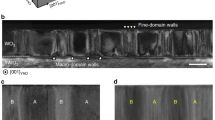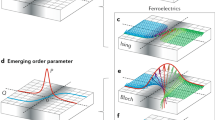Abstract
The inversion of inhomogeneous physical states has great technological importance; for example, active noise reduction relies on the emission of an inverted sound wave that interferes destructively with the noise of the emitter1, and inverting the evolution of a spin system by using a magnetic-field pulse enables magnetic resonance tomography2. In contrast to these examples, inversion of a distribution of ferromagnetic or ferroelectric domains within a material is surprisingly difficult: field poling creates a single-domain state, and piece-by-piece inversion using a scanning tip is impractical. Here we report inversion of entire ferromagnetic and ferroelectric domain patterns in the magnetoelectric material Co3TeO6 and the multiferroic material Mn2GeO4, respectively. In these materials, an applied magnetic field reverses the magnetization or polarization, respectively, of each domain, but leaves the domain pattern intact. Landau theory indicates that this type of magnetoelectric inversion is universal across materials that exhibit complex ordering, with one order parameter holding the memory of the domain structure and another setting its overall sign. Domain-pattern inversion is only one example of a previously unnoticed effect in systems such as multiferroics, in which several order parameters are available for combination. Exploring these effects could therefore advance multiferroics towards new levels of functionality.
This is a preview of subscription content, access via your institution
Access options
Access Nature and 54 other Nature Portfolio journals
Get Nature+, our best-value online-access subscription
$29.99 / 30 days
cancel any time
Subscribe to this journal
Receive 51 print issues and online access
$199.00 per year
only $3.90 per issue
Buy this article
- Purchase on Springer Link
- Instant access to full article PDF
Prices may be subject to local taxes which are calculated during checkout





Similar content being viewed by others
Change history
20 September 2018
Four incorrect figure citations in this Letter have been corrected online.
References
Hansen, C. H. Understanding Active Noise Cancelation (Spon Press, New York, 2001).
Jung, B. A. & Weigel, M. Spin echo magnetic resonance imaging. J. Magn. Reson. Imaging 37, 805–817 (2013).
Wang, K. F., Liuab, J.-M. & Renc, Z. F. Multiferroicity: the coupling between magnetic and polarization orders. Adv. Phys. 58, 321–448 (2009).
Fiebig, M., Lottermoser, Th., Meier, M. & Trassin, M. The evolution of multiferroics. Nat. Rev. Mater. 1, 16046 (2016).
Benedek, N. A. & Fennie, C. J. Hybrid improper ferroelectricity: a mechanism for controllable polarization-magnetization coupling. Phys. Rev. Lett. 106, 107204 (2011).
White, J. S. et al. Coupling of magnetic and ferroelectric hysteresis by a multicomponent magnetic structure in Mn2GeO4. Phys. Rev. Lett. 108, 077204 (2012).
Pershan, P. S. Nonlinear optical properties of solids: energy considerations. Phys. Rev. 130, 919–929 (1963).
Fiebig, M., Pavlov, V. V. & Pisarev, R. V. Second-harmonic generation as a tool for studying electronic and magnetic structures of crystals. J. Opt. Soc. Am. B 22, 96–118 (2005).
Singh, H. et al. Short range ferromagnetic, magneto-electric, and magneto-dielectric effect in ceramic Co3TeO6. J. Appl. Phys. 119, 044104 (2016).
Hudl, M. et al. Complex magnetism and magnetic-field-driven electrical polarization in Co3TeO6. Phys. Rev. B 84, 180404 (2011).
Li, W.-H. et al. Interplay between the magnetic and electric degrees of freedom in multiferroic Co3TeO6. Phys. Rev. B 85, 094431 (2012).
Tolédano, P. et al. First-order multi-k phase transitions and magnetoelectric effects in multiferroic Co3TeO6. Phys. Rev. B 85, 214439 (2012).
Ivanov, S. A. et al. Temperature-dependent multi-k magnetic structure in multiferroic Co3TeO6. Mater. Res. Bull. 47, 63–72 (2012).
Honda, T. et al. Coupled multiferroic domain switching in the canted conical spin spiral system Mn2GeO4. Nat. Commun. 8, 15457 (2017).
Harris, A. B. Identifying Landau order parameters and their transformation properties for complex multiferroics: the case of Mn2GeO4. Phys. Rev. B 96, 054422 (2017).
Honda, T., Ishiguro, Y., Nakamura, H., Wakabayashi, Y. & Kimura, T. Structure and magnetic phase diagrams of multiferroic Mn2GeO4. J. Phys. Soc. Jpn. 81, 103703 (2012).
Carolus, V. Topography and Manipulation of Magnetic Domains in Cobalt Tellurite. PhD thesis, Bonn Univ. (2014).
Tokunaga, Y. et al. Composite domain walls in a multiferroic perovskite ferrite. Nat. Mater. 8, 558–562 (2009).
Aizu, K. Possible species of ferromagnetic, ferroelectric, and ferroelastic crystals. Phys. Rev. B 2, 754–772 (1970).
Yamasaki, Y. et al. Magnetic reversal of the ferroelectric polarization in a multiferroic spinel oxide. Phys. Rev. Lett. 96, 207204 (2006).
Tokunaga, Y. et al. Multiferroic M-type hexaferrites with a room-temperature conical state and magnetically controllable spin helicity. Phys. Rev. Lett. 105, 257201 (2010).
Zhai, K. et al. Giant magnetoelectric effects achieved by tuning spin cone symmetry in Y-type hexaferrites. Nat. Commun. 8, 51 (2017).
Fiebig, M., Lottermoser, Th., Fröhlich, D., Goltsev, A. V. & Pisarev, R. V. Observation of coupled magnetic and electric domains. Nature 419, 818–820 (2002).
Birss, R. R. Symmetry and Magnetism Ch. 2, 3 (North-Holland, Amsterdam, 1966).
Leute, S., Lottermoser, Th. & Fröhlich, D. Nonlinear spatially resolved phase spectroscopy. Opt. Lett. 24, 1520–1522 (1999).
Fiebig, M., Fröhlich, D., Lottermoser, Th. & Maat, M. Probing of ferroelectric surface and bulk domains in ferroelectric RMnO3 (R = Y, Ho) by second harmonic generation. Phys. Rev. B 66, 144102 (2002).
Acknowledgements
J.S.W. thanks the SNSF for support via grant 200021_153451. M.K. acknowledges financial support by SNSF grant 200021_165855. S.A.I. acknowledges financial support from the Russian Foundation for Basic Research. M.F. is grateful for support by SNSF grant 200021_178825. We thank B. Harris for a discussion of the Landau theory for Mn2GeO4 in refs 14,15, prior to their publication.
Reviewer information
Nature thanks V. Gopalan and the other anonymous reviewer(s) for their contribution to the peer review of this work.
Author information
Authors and Affiliations
Contributions
All authors contributed to the discussion and interpretation of the experiment and to the completion of the manuscript. N.L. and V.C. performed the experiments. N.L., J.S.W. and M.K. interpreted the domain-pattern inversion on the basis of a previously published14,15 Landau-theoretical description of the order parameters. V.C., M.H. and P.T. performed the Landau-theoretical analysis of the Co3TeO6 experiments. M.W. grew single crystals of Co3TeO6 and S.A.I. analysed their stoichiometry and structure. T.H. and T.K. prepared single crystals of Mn2GeO4. Th.L. supervised the experiments on Co3TeO6. D.M. and M.F. initiated the experiment and supervised the work.
Corresponding author
Ethics declarations
Competing interests
The authors declare no competing interests.
Additional information
Publisher’s note: Springer Nature remains neutral with regard to jurisdictional claims in published maps and institutional affiliations.
Extended data figures and tables
Extended Data Fig. 1 Crystallographic structure, magnetic structure and optical excitation of Co3TeO6.
a, Three-dimensional view of the crystallographic unit cell along the x axis in relation to the magnetic propagation vectors k0 and k≠0. b, Section of the unit cell in the x–z plane showing the location of the paramagnetic Co2+ ions in five different positions. c, Magnetic moments of the Co2+ ions shown in b. d, Orientation of the spontaneous magnetization Mx,z and the electric polarization Py. The latter is symmetry-allowed as spontaneous polarization, yet observed only as a magnetic-field-induced contribution9,10,12. e, Geometry of the SHG transmission experiment with light at ω and 2ω propagating along the z axis, probing a z-cut Co3TeO6 platelet in perpendicular incidence. The sample is exposed to a magnetic field Hy.
Extended Data Fig. 2 Crystallographic structure, magnetic structure and optical excitation for Mn2GeO4.
a, Top, three-dimensional view of the crystallographic unit cell showing the location of the paramagnetic Mn2+ ions on the different positions ‘Mn1’ and ‘Mn2’. Bottom, orientation of the spontaneous magnetization Mz and spontaneous polarization Pz in relation to the magnetic propagation vectors k0 and k≠0. b, Conically modulated order of the magnetic Mn2+ moments on the Mn1 and Mn2 positions. Bold arrows show the resulting spontaneous magnetization Mz and spontaneous polarization Pz. c, As in b, but for reversed spontaneous magnetization. d, Geometry of the SHG transmission experiment with light incident onto a z-cut Mn2GeO4 platelet. The sample is exposed to a magnetic field Hz and it is rotated around the y axis so that the optical excitation does not occur in perpendicular geometry.
Extended Data Fig. 3 SHG coupling and interference.
a, Spatially resolved SHG image of a z-cut Co3TeO6 sample. At 5 K, a magnetization-induced SHG contribution from χxyy and a crystallographically induced SHG contribution from χyyy are present. The χxyy light waves from opposite domains differ by 180° because of proportionality to the spontaneous magnetization ±Mx,z. The phase of the χyyy wave is homogeneous across the sample because it is blind to the magnetic order. Constructive (+Mx,z) and destructive (−Mx,z) interference of the magnetic and crystallographic SHG contributions therefore yields the opposite magnetic domain states as regions of different brightness. b, Image of the same region as in a but at 30 K, at which Mx,z = 0 so that only the homogeneous crystallographic SHG contribution from χyyy remains. Scale bar, 500 μm.
Extended Data Fig. 4 Inversion of the ferroelectric domain pattern in an x-cut Mn2GeO4 sample.
Sequentially taken SHG images of ±Pz domains on an x-oriented Mn2GeO4 sample at the given magnetic fields Hz. The same domain-inversion behaviour as for the z-cut sample in Fig. 4 is observed. Because of the small SHG contrast, opposite polarization domain states are highlighted by colour shading. Darker or black areas are caused by cracks and pores in the Mn2GeO4 sample. Scale bar, 500 μm.
Rights and permissions
About this article
Cite this article
Leo, N., Carolus, V., White, J.S. et al. Magnetoelectric inversion of domain patterns. Nature 560, 466–470 (2018). https://doi.org/10.1038/s41586-018-0432-4
Received:
Accepted:
Published:
Issue Date:
DOI: https://doi.org/10.1038/s41586-018-0432-4
Keywords
This article is cited by
-
Terahertz control of many-body dynamics in quantum materials
Nature Reviews Materials (2023)
-
Time-dependent exchange creates the time-frustrated state of matter
Scientific Reports (2022)
-
Emerging spin–phonon coupling through cross-talk of two magnetic sublattices
Nature Communications (2022)
-
Magnetoelectric phase transition driven by interfacial-engineered Dzyaloshinskii-Moriya interaction
Nature Communications (2021)
-
Seeing is believing: visualization of antiferromagnetic domains
npj Quantum Materials (2020)
Comments
By submitting a comment you agree to abide by our Terms and Community Guidelines. If you find something abusive or that does not comply with our terms or guidelines please flag it as inappropriate.



